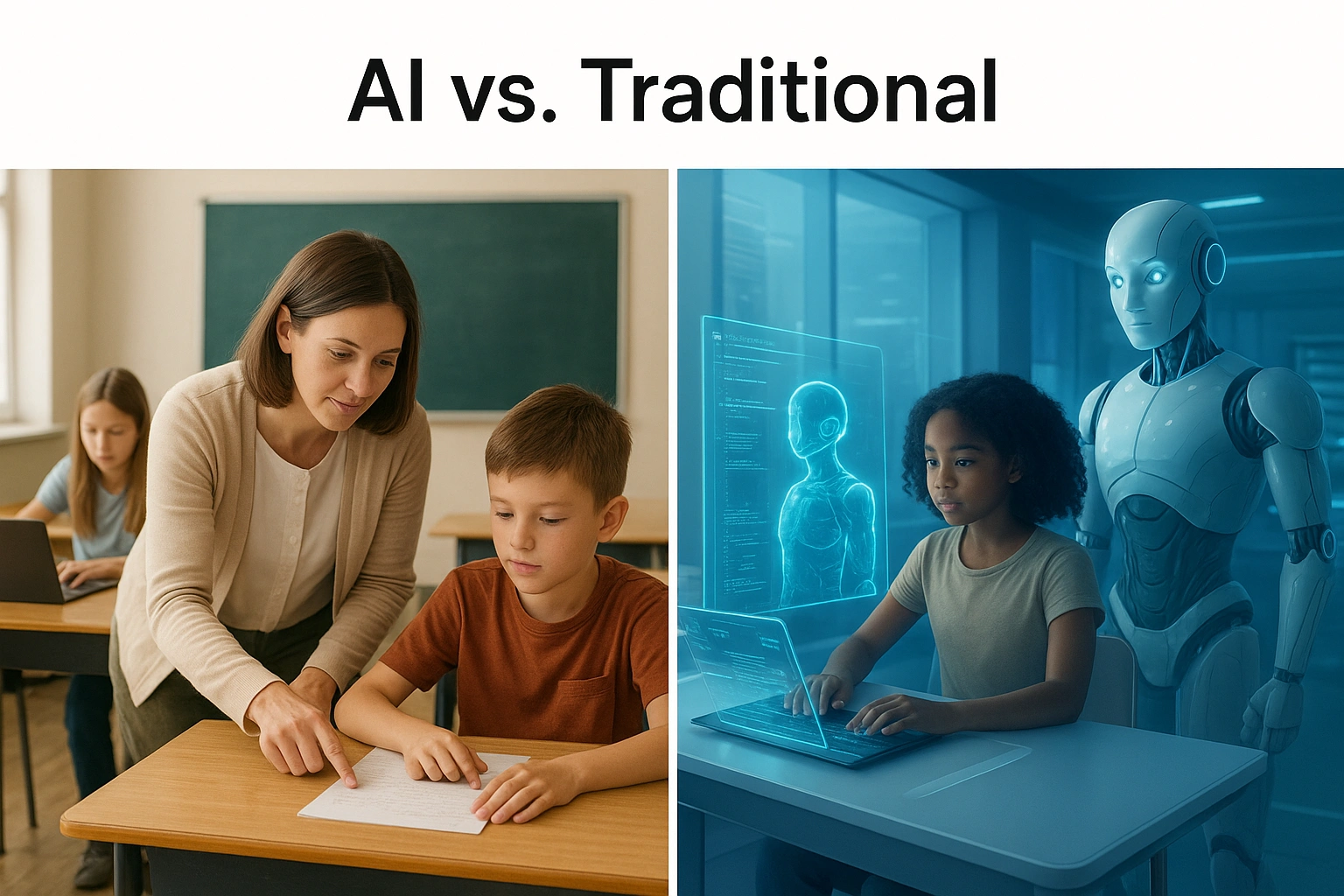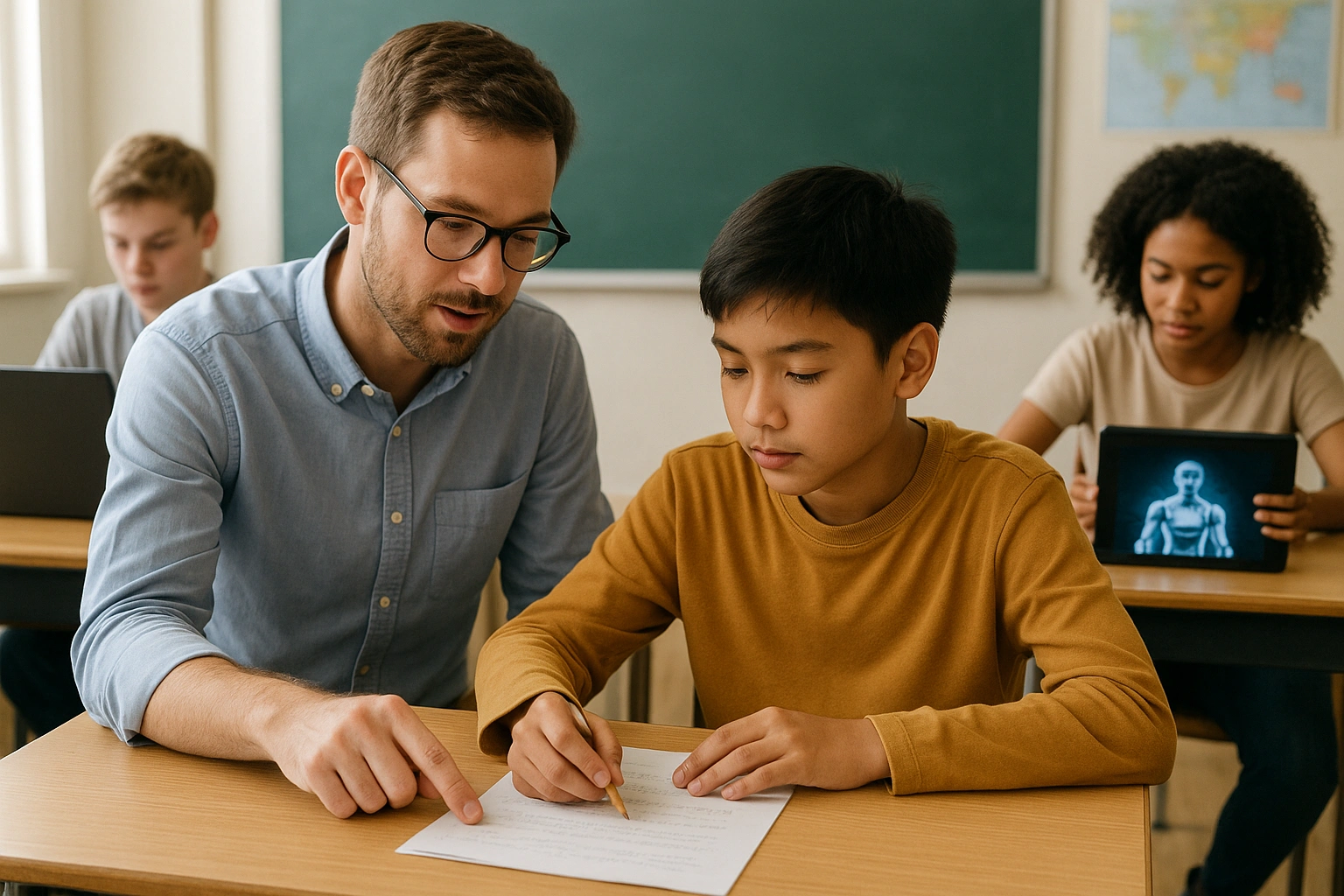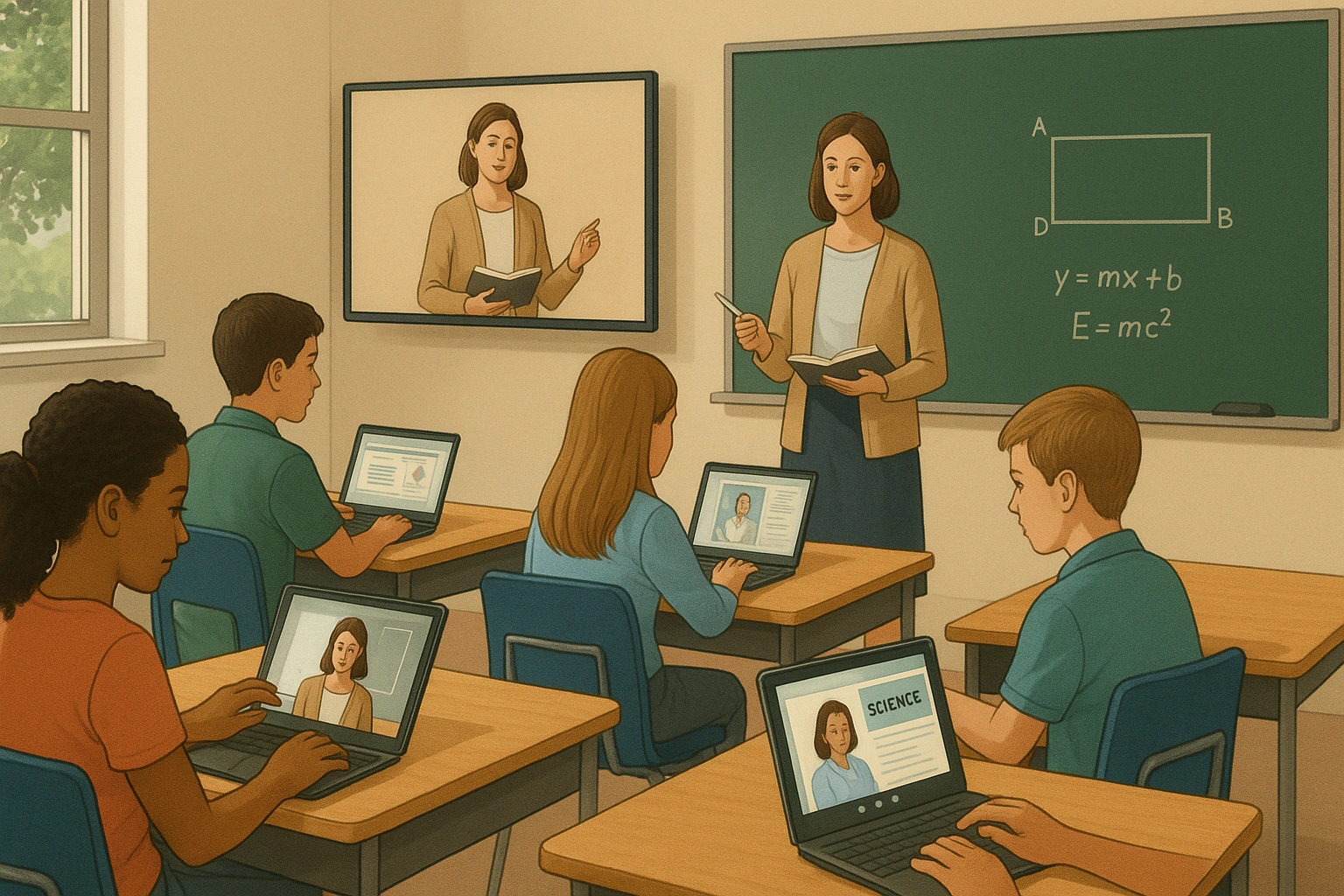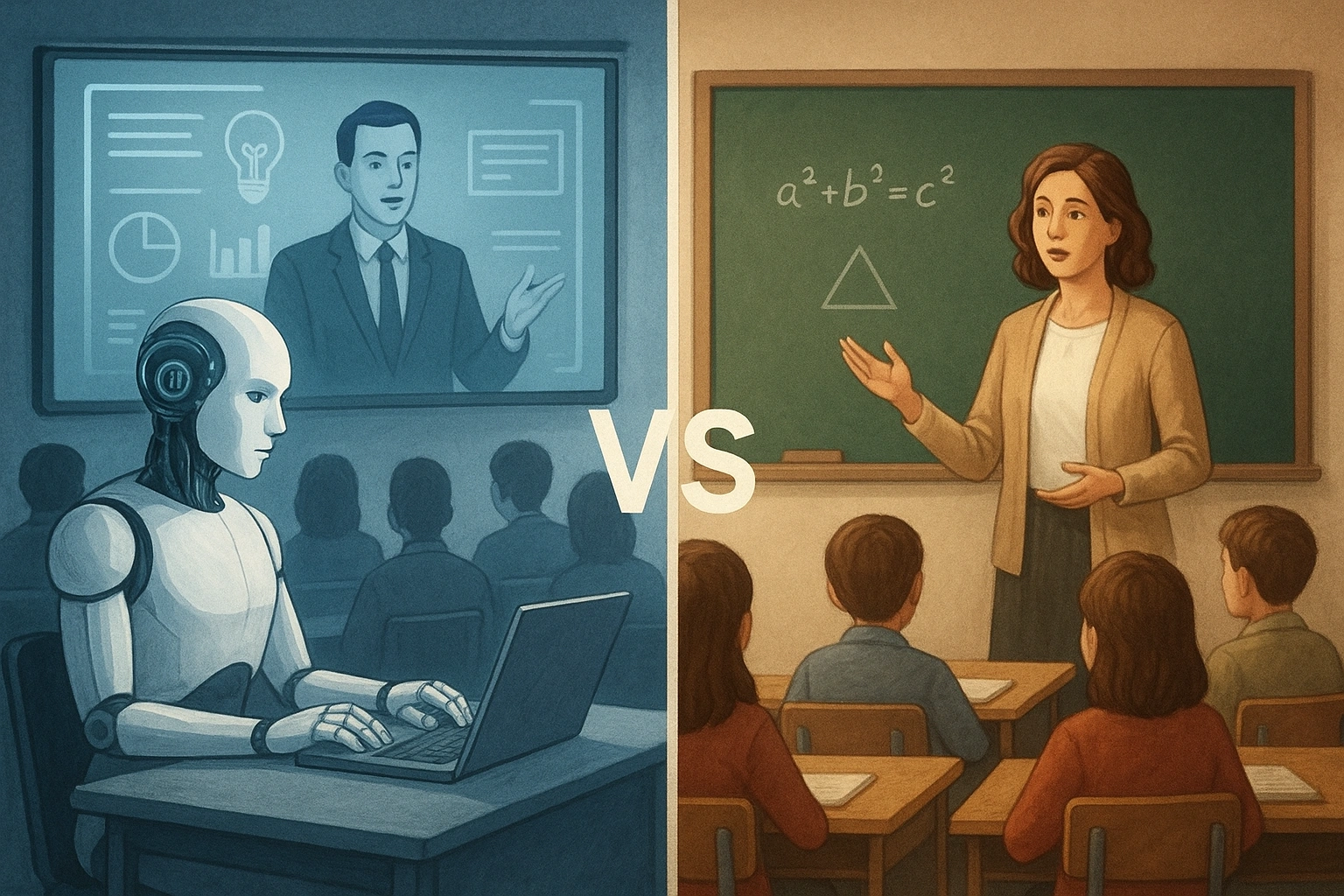Introduction
Defining the Contenders: Two Philosophies of Learning
What is Traditional Education?
Traditional education is the teacher-centric model most of us grew up with. Its key characteristics include a standardized curriculum delivered to a group, a fixed learning pace for all students, and assessments (like tests and essays) that occur at specific intervals. The teacher is the primary source of knowledge, and learning often happens within the physical confines of a classroom. Its strength lies in its ability to efficiently deliver foundational knowledge to large groups and foster social learning through direct peer interaction.
What is AI-Powered Education?
AI-powered education is a student-centric, technology-driven model. It uses algorithms to create personalized learning paths for each student, adapting in real-time to their strengths, weaknesses, and learning pace. The system gathers data from every interaction to provide continuous feedback and predictive insights. Here, the AI acts as a co-pilot or tutor, while the human teacher transitions to a facilitator role, focusing on higher-order thinking and mentorship. According to Statista, the global AI in education market is projected to grow exponentially, signaling a massive systemic shift toward this model.

The Core Differences: A Head-to-Head Comparison
The debate over **AI vs traditional education** comes down to several key functional differences. Let’s break them down in this detailed **teaching methods comparison**.
| Feature | Traditional Education | AI-Powered Education |
|---|---|---|
| Learning Path | Linear and standardized; all students follow the same sequence. | Adaptive and personalized; the path changes based on individual performance. |
| Pace of Learning | Fixed; determined by the teacher for the entire group. | Variable; students can accelerate through concepts they master or slow down for those they find difficult. |
| Assessment | Summative and periodic (midterms, finals). Feedback is often delayed. | Formative and continuous; every interaction is an assessment point, providing instant feedback. |
| Data & Insights | Based on teacher observation and test scores; often anecdotal. | Granular, real-time analytics on engagement, mastery, and potential learning gaps. |
| Role of Teacher | “Sage on the Stage” – the primary dispenser of knowledge. | “Guide on the Side” – a facilitator, mentor, and learning architect. |
This shift in data analysis is profound. A traditional teacher might notice a student is struggling after they fail a quiz. An AI system can predict that a student is *likely* to fail the quiz next week based on their hesitation on certain practice problems, allowing for proactive intervention. This is similar to how a well-structured financial report can predict future cash flow issues before they happen.
A Tale of Two Classrooms: 8th Grade Algebra
To make this comparison more concrete, let’s imagine a lesson on solving linear equations in two different settings.
The Traditional Classroom
Mr. Harrison stands at the front of the room, explaining the substitution method to his 28 students. He works through three examples on the whiteboard. He then assigns a 20-problem worksheet. As students work, he circulates, answering questions. He notices that a few students finish in 10 minutes and look bored, while a group in the back is completely lost. He spends most of his time with the struggling group, while the advanced and average students work independently. The next day, he collects the worksheets to grade that night.
The AI-Powered Classroom
Ms. Chen’s students are on their tablets. The AI platform has already used data from previous lessons to identify that 5 students have mastered the prerequisite concepts, 18 have a solid foundation, and 5 are still struggling with isolating variables. The advanced students are immediately given a challenging project: creating a real-world word problem that requires a system of equations. The core group gets an interactive tutorial with guided practice. The struggling group receives a targeted micro-lesson on the prerequisite skill. As they work, Ms. Chen’s dashboard flags two students from the core group who are making a common error. She pulls them aside for a 5-minute mini-lesson. At the end of the class, she has a complete report on every student’s progress, no grading required.

The Irreplaceables: What Traditional Education Does Better
The AI-powered classroom sounds incredibly efficient, but the **AI vs traditional education** debate isn’t one-sided. Traditional education cultivates critical human skills that AI cannot replicate.
- Social-Emotional Learning (SEL): AI can’t teach empathy, resolve a playground dispute, or notice when a student is having a bad day. The classroom is a complex social ecosystem where children learn collaboration, resilience, and self-awareness from a human role model and their peers.
- Inspiration and Mentorship: No algorithm can replace the impact of a passionate teacher who ignites a student’s curiosity for a subject. The human connection, the shared enthusiasm, and the role-modeling that a great teacher provides are often the most memorable and impactful parts of a person’s education.
- Spontaneous Creativity: Traditional classrooms allow for spontaneous, unplanned moments of discovery and creativity. A student’s off-the-wall question can lead the entire class down a fascinating rabbit hole of inquiry that an algorithm, bound by its programming, would never explore.
Myth vs. Fact: Debunking Common AI Fears
The rise of AI in education has been accompanied by significant anxiety. Let’s separate the myths from the facts.
| Myth | Fact |
|---|---|
| AI will replace teachers. | AI will augment teachers, not replace them. It automates administrative tasks and personalization, freeing up teachers to focus on mentorship, critical thinking, and social-emotional support—the parts of the job that are uniquely human. |
| AI education is isolating and anti-social. | When implemented correctly, AI can enhance collaboration. By handling individualized instruction, it frees up class time for project-based learning. AI can even create optimal student groups based on complementary skills. |
| AI is only useful for STEM subjects. | This is no longer true. Modern AI tools can provide feedback on essay structure, act as a conversation partner for language learning, and create simulations for history lessons. Its applications are now cross-curricular. |
Best Practices for a Hybrid Future
The most likely future isn’t a victory for one side, but a synthesis of both. Experts advocate for a “hybrid” or “blended” model that combines the best of **AI vs traditional education**.
- Use AI for Differentiation, Humans for Connection: Let the AI handle the mechanical task of personalizing practice and content delivery. Use the time saved for one-on-one check-ins and Socratic seminars.
- Implement a “Flipped Classroom” Model: Have students learn foundational concepts at home via an AI-powered platform. Use precious class time for collaborative projects, labs, and deep discussions.
- Prioritize Teacher Training: The most important investment isn’t in the software, but in training teachers how to use it as a pedagogical tool. Professional development should focus on data literacy and how to integrate AI insights into instructional strategies.
- Maintain “Unplugged” Time: Deliberately schedule parts of the school day that are screen-free. Time for hands-on projects, unstructured play, and face-to-face conversation is critical for holistic development.
“Stop thinking of it as ‘AI versus teachers.’ Start thinking of it as ‘teachers with AI superpowers.’ The goal is to fuse the efficiency of the machine with the wisdom and empathy of the human educator,” says ed-tech futurist Dr. Kenji Tanaka.

FAQ Section
Which is better for young children (Pre-K to 2nd Grade), AI or traditional education?
For this age group, traditional, play-based education is overwhelmingly considered superior. The development of fine motor skills, social-emotional regulation, and interpersonal skills through hands-on activities and human interaction is paramount. AI can be a supplemental tool, but it should not be the primary mode of instruction.
Can AI effectively grade complex subjects like art or creative writing?
AI is getting surprisingly good at this. It can assess technical aspects like grammar, structure, and adherence to a prompt. However, it still struggles to evaluate true creativity, emotional impact, and nuance. The best approach is to use AI for a “first pass” on technical criteria, leaving the final, holistic grade to the human teacher.
What is the biggest challenge in transitioning from traditional to AI-powered education?
The biggest challenge is cultural change and teacher training. Shifting the mindset of an entire school from a teacher-led model to a student-centric, data-driven one requires significant, ongoing professional development and administrative support.
How does the cost of AI vs traditional education compare in the long run?
While there is an initial investment in devices and software, many AI systems can lead to long-term savings. By increasing student retention, providing scalable tutoring, and improving teacher efficiency, AI can offer a significant return on investment, as seen in many university case studies.
Will AI widen the achievement gap between different schools?
This is a major concern. If high-quality AI is only available to wealthy schools, it could widen the gap. However, the proliferation of affordable and even free AI tools (as covered by sources like TechCrunch) offers the potential to do the opposite: close the gap by providing high-quality, personalized instruction in under-resourced schools.
Conclusion: The Synthesis of a New Era
